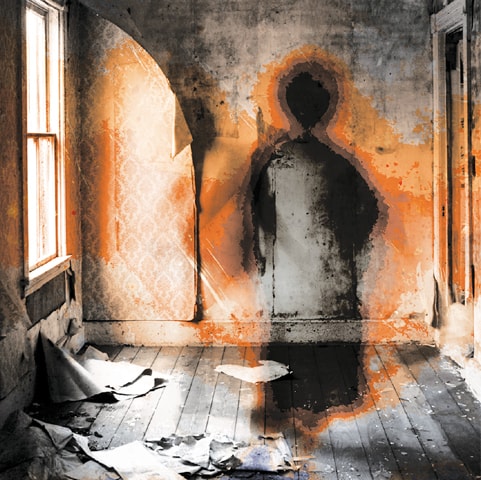
The ghost story is a tricky genre to venture into as it is set ambiguously somewhere between supernatural fiction and horror. Ghost stories do incorporate horror undertones in the narrative, but place greater emphasis on insinuating suspense. Traditionally, the horror is only implied in this genre with implicit details relayed through mise en scène, allowing the readers to subjectively interpret the underlying trepidation.
The Silent Children by Amna K. Boheim interweaves the supernatural and the mysterious when the sudden suicide of the mysteriously reticent Annabel compels her estranged son, Max, to piece together all the fragments of her life shrouded in secrecy to make some sense of her drastic final act. After years of distance between them, Max finds a photograph sent to him by Annabel in her last days, of herself and a little boy, Oskar, bearing an expression of absolute horror. This photo seems like just another relic of the past, at least on the surface. The mysterious message on the back of this seemingly inconspicuous photo, however, suggests deeper, more sinister implications. Max, in trying to decipher the mysterious message, ends up opening a Pandora’s box of long buried familial secrets which form the crux of the novel.
The story moves back and forth in time with Max’s narration based in London in 2004, and Annabel’s diary entries of 1938 in Vienna, Austria, during the time of National Socialism. The latter tells us how Annabel’s and her parents’ — who ran the prestigious orphanage named Albrecht Trust — picture-perfect life of privilege and familial bliss slowly unravels in the face of mounting tensions due to Germany’s annexation of Austria. To add to the crisis, there are inexplicable disappearances among Annabel’s household: first her nanny disappears, then her friend Oskar.
A novel with a mystery at its centre, expounding on the nature of revenge and redemption
The writer embellishes her narrative with traditional Jamesian elements, named after M.R. James, the writer of seminal ghost stories who believed that two of the most effective characteristics of ghost stories were the atmosphere and a balanced crescendo. The trick was to subliminally depict the paranormal elements amongst mundane settings, creating an environment that would be more atmospheric than horrifying. This juxtaposing of the mundane with the metaphysical creates an elevated ambience of eeriness which is much more effective than the hyperbolic gore present in most horror stories. The Silent Children, for the most part, manages to harmonise both these features. The writer does not rush the critical junctures of the plot to spike up the suspense quotient, which results in prose that is remarkably restrained, especially for a debutant, with the mystery allowed to unfurl at a steady pace.
Boheim employs stock horror tropes such as a creepy puppet theatre in the attic, an ominous painting which seems to be straight out of H.P. Lovecraft’s ‘Pickman Model’ and a recurrent apparition of a little girl in the house. It is to her credit, however, that she effectively uses these archetypal images to make them seem genuinely scary: “She was smiling, but it was a smile that didn’t belong to her, making her look as though she’d had her memory erased. Her vacant gaze was transfixed on the corner of the room. I followed her line of sight to the curtains. I was about to draw closer when they seemed to move. I froze. I thought I saw a hint of a small body crouched behind them, tugging the material tighter around itself. The child, the girl that I’d seen down in the cellar, flickered through my mind. My stomach knotted”.
“I couldn’t understand it. I had heard something. I was certain. I looked beyond the room to where the corridor narrowed towards the wall at the far end. It was now blanketed in darkness. Although a part of me longed to leave, I kept going, tripping over forgotten household equipment and cardboard boxes. The corridor stretched another few metres or so, but in the feeble light, the distance seemed much greater, and the further I went, the more I felt the ice cold of the stone pervade the soles of my bare feet.” — Excerpt from the book
The ghosts in the story give impetus to the main plot line rather than interfere with it, which is refreshing. Quintessential horror elements like imaginary friends who turn out to be malignant spectres, and cryptic messages on paper are not used in isolation, but serve to point the protagonist in the right direction. The pulsating horror of the house is all the more comprehensible due to the use of evocative language: “Pictures hung askew, a vase lay half broken on the landing. I tracked their handiwork. The damaged banister looked like a dismembered body”.

Initially, Max is incredulous about the possibility of any otherworldly presence at work, as any other pragmatic person would be under the circumstances. His journey from being sceptical of the occult, to the dissonance he faces after some inexplicable episodes, helps readers identify with his character. However, where Boheim excels in etching out a relatable character in Max, she somewhat falters in extending the same depth to the rest of her characters. The crucial characters of Vivienne and Annabel had the potential to be delved into deeper, but they are reduced to serve largely as mere propulsive agents in the story.
As the story progresses, Max finds out how rattling the skeletons in the closet sometimes brings no closure, but instead propels one down a rabbit hole. He realises that the ghosts of the past are seeking retribution with a vengeance for past sins and will not settle for anything less.
The reviewer is a Karachi-based freelance writer and book critic.
The Silent Children
(NOVEL)
By Amna K. Boheim
Troubador Publishing Ltd, UK
ISBN: 978-1784625160
290pp.
Published in Dawn, Books & Authors, October 23rd, 2016















































Dear visitor, the comments section is undergoing an overhaul and will return soon.